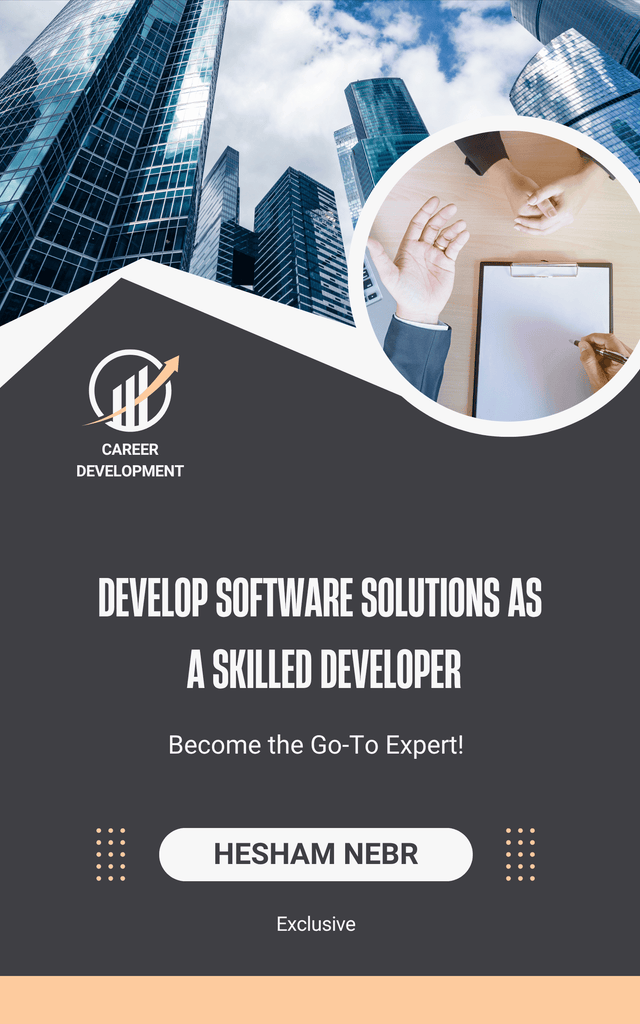Categories
Custom Services
-
Free Delivery
From $99.89
-
Support 24/7
Online 24 hours
-
Free return
365 a day
-
Secure Payments
Visa and Master card
Develop Software Solutions as a Skilled Developer -Book By Hesham Nebr
$10.00 $25.00
Embark on a transformative journey through software development with this comprehensive guide designed specifically for skilled developers. Each chapter unfolds essential lessons that foster technical mastery, collaboration, and innovative practices, ensuring your growth in an ever-evolving industry.
Chapter 1 emphasizes the importance of striving for process improvements and automation within financial management, as well as nurturing innovation and continuous learning in finance teams. You will discover how consistently enhancing your coding skills through new languages and technologies can elevate your development effectiveness.
In Chapter 2, stay ahead of industry trends and familiarize yourself with the latest software development methodologies. Learn to write clean, readable code that adheres to best practices and coding standards while enhancing your code's maintainability through thorough commenting.
Chapter 3 focuses on practical skills that empower you as a developer. Utilize version control systems, like Git, to track changes effectively while honing problem-solving skills for efficient debugging. Embrace test-driven development by writing tests that ensure code quality.
Collaboration is at the forefront of Chapter 4, where you will engage in code reviews for mutual learning and enhanced code quality. The importance of documenting your code, APIs, and architecture for clearer understanding is also highlighted, along with following secure coding practices to protect against vulnerabilities.
In Chapter 5, learn the power of continuous integration and deployment to streamline your development process. Emphasizing user experience in software design is crucial, as is employing performance optimization techniques to create efficient applications.
Chapter 6 dives into database understanding, underscoring its effective utilization in applications. You will also explore the significance of regularly refactoring code to enhance readability and performance while ensuring your development environment is well-configured and up-to-date.
Leverage open-source libraries in Chapter 7 to accelerate your development and reduce duplication. With project management tools and Agile methodologies, staying organized becomes achievable, and continuous learning will keep you aligned with evolving technologies.
Chapter 8 encourages you to attend conferences to network with fellow developers while embracing code reusability and modularity in your projects. Learn effective time management strategies to successfully meet project deadlines.
In Chapter 9, cultivate strong communication skills to facilitate collaboration with teams and stakeholders. Thoroughly understanding software requirements prior to development will ensure the foundation of your projects, alongside implementing robust error handling and exception management in your code.
Chapter 10 underscores the significance of following accessibility guidelines for universal software usability. Moreover, optimizing applications for multiple devices guarantees a seamless user experience, while practicing empathy in software design will help you understand and meet user needs effectively.
Explore personal growth in Chapter 11, where you balance technical breadth with deeper expertise in specific areas while committing to continuous learning. A proactive approach to seeking user feedback will enhance iterative improvements in your software.
Chapter 12 focuses on self-reflection and assessment as a pathway to personal and professional growth. Building healthy habits, including regular sleep patterns and a balanced diet, supports your overall well-being, while practicing active listening will enhance your understanding of others' perspectives.
Engage in professional development in Chapter 13 by maintaining a positive online presence and taking responsibility for your actions. Seek mentors or role models to gain guidance and inspiration on your professional journey.
In Chapter 14, focus on investing in emotional intelligence and empathy. Constantly challenging yourself to expand your knowledge and skills, as well as evaluating your progress toward goals, encourages a mindset of growth.
Chapter 15 invites you to seek new experiences beyond your comfort zone, which is vital for building self-confidence and self-belief. Furthermore, mastering emotional regulation will empower you to navigate complex professional landscapes.
Networking and decision-making skills are covered in Chapter 16, aiding you in developing a robust professional network while practicing effective decision-making by weighing your options and their respective consequences. Continuously seeking feedback and learning opportunities will enrich your professional development.
Chapter 17 equips you with innovative strategies to showcase your skills effectively on your resume, delineating the top skills employers seek and introducing power words that can make your resume stand out.
In Chapter 18, discover the best offline job search methods, complemented by a look at top job search websites to leverage. Learn the essential dos and don’ts when applying for jobs online to enhance your application effectiveness.
Chapter 19 focuses on the critical stage of job interviewing. Understand how to research a company thoroughly, alongside the dos and don’ts of professional attire to ensure a polished appearance.
Chapter 20 prepares you for successful interviews by reviewing common questions and crafting thoughtful responses. Vocal practice can boost your confidence in delivery while maintaining a professional appearance is key.
Chapter 21 offers proven strategies to increase email open rates and reveals the dos and don’ts of email marketing to achieve business success. Timeliness and thoughtfulness in follow-ups after an interview can further enhance your professional rapport.
In Chapters 22 and 23, explore effective methods for creating a stunning social media portfolio, including innovative strategies for displaying your work. Learn how to build an email list from scratch and the best practices for running successful paid advertising campaigns across various platforms.
This book will serve as a vital resource, steering skilled developers towards proficiency, adaptability, and excellence in their craft.

 English
English Arabic
Arabic




